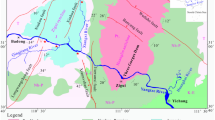Abstract
The GNSS deformation monitoring network of the Three Gorges Reservoir is introduced. The GNSS monitoring strategy from 2011 to 2012 is elaborately analyzed from technology design, field observation, data processing and deformation analysis. The baseline length variations of these GNSS stations from 2011 to 2012 are less than 5 mm, and the vertical variation of each station is about 10 mm. The computing results show that the two-year’s variation of the crustal deformation is small, and then the surface structure variation is stable in present around the Three Gorges Reservoir area.
Access this chapter
Tax calculation will be finalised at checkout
Purchases are for personal use only
Preview
Unable to display preview. Download preview PDF.
Similar content being viewed by others
References
Gough, D.I., Gough, W.I.: Time dependence and trigger mechanisms for the Kariba (Rhodesia) earthquakes. Eng. Geol. 10(2-4), 211–218 (1976)
Hubbert, M.K., Rubey, W.W.: Mechanics of fluid-filled porous solids and its applications to overthrust faulting. Geol. Soc. Ame. Bull. 70, 115–166 (1959)
Yu, T.: Crustal deformation and reservoir-induced earthquakes. Crustal Deformation and Earthquake 11(2), 8–16 (1991)
Du, R., Xing, C., Wu, Z., et al.: Crustal deformation of Three Gorges Area. Journal of Geodesy and Geodynamics 24(2), 23–29 (2004)
Zhang, P., Wang, Q., Ma, Z.: GPS velocity field and active crustal blocks of contemporary tectonic deformation in continental CHINA. Earth Science Frontiers 9(2), 430–441 (2002)
Wang, W., Yang, S., Zhao, B., et al.: Present-day crustal movement velocity field in Chinese mainland. Journal of Geodesy and Geodynamics 6, 29–32 (2012)
Li, Q., You, X., Yang, S., et al.: A precise velocity field of tectonic deformation in China as inferred from intensive GPS observations. Sci. China Earth Sci. 55, 695–698 (2012)
Chen, S.: Atlas of geo-science analyses of Landsat imagery in China. National Remote Sensing Centre, Chinese Academy of Science. Science Press, Beijing (1986)
Wu, S., Hu, D., Chen, Q., Xu, R., Mei, Y.: Assessment of the crustal stability in the Qingjiang river basin of the western Hubei Province and its peripheral area, China. In: Proceedings of the Thirtieth International Geological Congress, Beijing, China, pp. 375–385. VSP International Science Publishers, Zeist (1997)
Li, A., Zeng, X.: Engineering Earthquake in the eastern Yangtze Gorges area. Seismological Press, Beijing (1996)
Hu, X., Qin, X.: Research on Reservoir-induced Earthquake Monitoring in Three Gorges Area. Engineering Science 5(11), 71–74 (2003)
Sun, Y., Tan, C., Wang, R., Hu, D.: An assessment and zonation of regional crustal stability in and around the dam region of the Three Gorges Project on the Yangtze River. Acta Geoscientica Sinica 17(3), 258–268 (1996)
Han, X., Rao, Y.: Analysis of genesis of reservoir-induced microquakes in Badong reach of Three Gorges. Journal of Geodesy and Geodynamics 24(2), 74–77 (2004)
Xing, C., Gong, K., Du, R.: Crustal deformation monitoring network for three gorges project on Yangtze river. Journal of Geodesy and Geodynamics 23(1), 114–118 (2003)
Niu, Z., You, X., Wang, Q., Wang, M.: Velocity fields of crust movement of china: comparison between results with GAMIT and GISPY. Journal of Geodesy and Geodynamics 23(3), 4–8 (2003)
Dongchen, E., Zhan, B., Jiang, W., Zhang, S.: High-precision GPS data processing by GAMIT/GLOBK. Chinese Journal of Polar Research 17(3), 173–182 (2005)
Lu, C., Wang, J.: Data processing for GPS crust movement monitoring network. Journal of Geodesy and Geodynamics 22(4), 56–60 (2002)
Author information
Authors and Affiliations
Editor information
Editors and Affiliations
Rights and permissions
Copyright information
© 2013 Springer-Verlag Berlin Heidelberg
About this paper
Cite this paper
Jia, Z., Liu, G., Wang, W., Zhou, Y. (2013). GNSS Investigation in the Early Stage of the Three Gorges Project on the Yangtze River. In: Bian, F., Xie, Y., Cui, X., Zeng, Y. (eds) Geo-Informatics in Resource Management and Sustainable Ecosystem. GRMSE 2013. Communications in Computer and Information Science, vol 399. Springer, Berlin, Heidelberg. https://doi.org/10.1007/978-3-642-41908-9_40
Download citation
DOI: https://doi.org/10.1007/978-3-642-41908-9_40
Publisher Name: Springer, Berlin, Heidelberg
Print ISBN: 978-3-642-41907-2
Online ISBN: 978-3-642-41908-9
eBook Packages: Computer ScienceComputer Science (R0)




